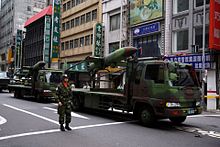This is an old revision of this page, as edited by Horse Eye's Back (talk | contribs) at 18:52, 14 March 2023 (→Albatross II). The present address (URL) is a permanent link to this revision, which may differ significantly from the current revision.
Revision as of 18:52, 14 March 2023 by Horse Eye's Back (talk | contribs) (→Albatross II)(diff) ← Previous revision | Latest revision (diff) | Newer revision → (diff)| NCSIST Albatross | |
|---|---|

| |
| Role | UAVType of aircraft |
| Manufacturer | National Chung-Shan Institute of Science and Technology |
| Introduction | 2007 |
| Status | In service |
| Primary user | Republic of China Navy |
| Number built | >32 |
| Developed from | Chung Shyang I |




The Albatross, also known as the Chung Xiang II, is a medium unmanned aerial vehicle made by National Chung-Shan Institute of Science and Technology. It is in service with the Republic of China Navy.
Design
The Chung Shyang II UAV can perform surveillance, reconnaissance, target acquisition, artillery spotting and battle damage assessment sorties for the military and perform other duties such as border patrol, and aerial reconnaissance for various government agencies.
The Albatross has a wingspan of 8 meters and a range of more than 180km. Endurance is approximately 12 hours. It carries an electro-optical payload and can operate in both day and night. In addition to its military capabilities the Albatross can also be used for civilian applications such as agriculture, fisheries, animal husbandry, disaster monitoring, environmental protection, traffic control, target searching, position recognition, coastal patrol, communications relay, and hazardous terrain survey. Officials have refused to comment on whether the type can be armed.
Development
CSIST unveiled a prototype of the UAV at the Taipei Aerospace & Defense Technology Exhibition in August, 2005. CSIST began researching UAVs in 2002, which resulted in the first Chung Shyang I UAV, then later the Chung Shyang II.
Service history
In 2017 the drones were transferred from the Army Aviation and Special Forces Command to the Naval Fleet Command.
In 2019 a Navy Albatross made the types first fly-over demonstration during an exercise in Pingtung.
Following a 2019 crash the military ordered upgrades to be made across the entire Albatross fleet, by May 2020 NCSIST had completed upgrades on 26 aircraft.
Incidents
The Albatross has crashed three times in 2012, 2013, and 2016.
On Jan. 24 2018, an Albatross crashed into the sea during a military exercise off of Taitung. Mechanical failure is suspected to be the cause of the crash.
In May 2021 an Albatross was brought down in the waters off Taitung County by its control team after experiencing in-flight anomalies. The control crew made the decision not to risk civilian lives by attempting to return to the airport. This was believed to be the ninth crash of the Albatross since 2012.
Variants
Albatross II
Albatross II is an improved model developed by NCSIST and GEOSAT aerospace & technology. Its range is increased with endurance, communications range, and payload also being increased. Unlike Albatross I, it has a synthetic aperture radar. It is compatible with Sky Sword missiles and 2.75in rockets. It has a reported range of 300km and a maximum loitering time of 16 hours. Artificial intelligence has also been introduced into the surveillance and tracking system.
Operators
Former operators
 Taiwan
Taiwan
- Republic of China Army 32 in service in 2014, transferred to the Republic of China Navy.
Specifications
Albatross I
Data from Taiwan News
General characteristics
- Length: 5.3 m (17 ft 5 in)
- Wingspan: 8.6 m (28 ft 3 in)
- Gross weight: 317 kg (699 lb)
Performance
- Range: 180 km (110 mi, 97 nmi)
- Endurance: 12 hours
- Service ceiling: 4,000 m (13,000 ft)
Albatross II
Data from Focus Taiwan
General characteristics
Performance
- Range: 250 km (160 mi, 130 nmi)
See also
References
- Ng, JR (August 2019). "Asia-Pacific Unmanned Aerial Vehicle Directory 2018". Asia Military Review: 14–27. Retrieved 17 January 2020.
- ^ Keck, Zachary. "Taiwan's Using Drones to Spy on China". thediplomat.com. The Diplomat. Retrieved 17 July 2019.
- Elaine Hou and Kuo Chung-han, Rita Cheng. "New U.S. drone sale policy could be good for Taiwan". focustaiwan.tw. Focus Taiwan. Retrieved 17 January 2020.
- ^ and Evelyn Kao, Wang Cheng-chung. "Albatross drone makes first fly-over demonstration in Pingtung". focustaiwan.tw. Focus Taiwan. Retrieved 17 January 2020.
- "Albatross Tactical Unmanned Aircraft Systems". www.ncsist.org.tw. NCSIST. Retrieved 17 January 2020.
- Peck, Michael (2017-08-08). "Taiwan shows off UAVs". www.c4isrnet.com. C4ISR.net. Retrieved 17 January 2020.
- SOBIE, BRENDAN. "Government-controlled CSIST unveils Chung Shyang II mock-up and hopes to develop strike version for military". www.flightglobal.com. Flight Global. Retrieved 17 July 2019.
- ^ Chen, Kelvin (18 May 2020). "Taiwan's Navy upgrades drone fleet". www.taiwannews.com.tw. Taiwan News. Retrieved 18 May 2020.
- "Taiwan upgrades Albatross tactical UAVs". www.janes.com. Janes. Retrieved 23 May 2020.
- Yeh, Joseph (2016-10-28). "Military UAV goes missing during training exercise: Taiwanese Army". www.asianews.eu. Asia News. Retrieved 17 July 2019.
- Yu-chen, Chung; Lu, Tyson; Lim, Emerson. "Taiwan-developed military drone crashes into sea". focustaiwan.tw. Focus Taiwan. Retrieved 21 May 2021.
- ^ Lin, Sean. "FEATURE/Asymmetrical warfare focus has Taiwan drone companies upping the ante". focustaiwan.tw. Focus Taiwan. Retrieved 10 September 2022.
- Cheung, Eric. "Taiwan unveils its new combat and surveillance drones as China threat grows". cnn.com. CNN. Retrieved 14 March 2023.
- "中科院銳鳶無人機 獲馬來西亞訂單".
| National Chung-Shan Institute of Science and Technology (NCSIST) aircraft | |
|---|---|
| Fixed-wing aircraft | |
| Missiles | |
| Radars | |